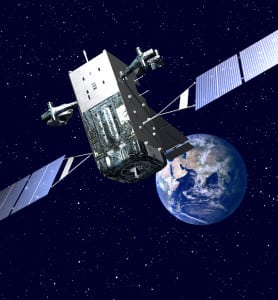The Air Force’s Next Generation Overhead Persistent Infrared (OPIR) Geosynchronous Earth Orbiting (GEO) early missile warning satellite program finished its system/ground and space vehicle preliminary design review (PDR) last month, the service said Friday.
The Next Generation OPIR program aims to replace the Air Force’s current set of space-based infrared surveillance satellites. The first block of the new constellation will include with five satellites, three in geosynchronous orbit and two in polar orbit. This PDR applied to the GEO portion and was completed on Sept. 27.

The Air Force said this milestone shows the program is on track for a rapid delivering of the first satellite for launch by 2025. The service will next start a12-month PDR campaign at the subsystem and component level.
Block 1-3 of the Next Generation OPIR system will use the Lockheed Martin [LMT] (LM) 2100 common satellite bus. The Air Force noted the company recently enhanced the LM 2100 to add capabilities that help across several mission areas including OPIR. This includes elimination of obsolescence and insertion of modern electronics in various subsystems and increased resiliency capabilities, that “are all applicable to the Next Gen OPIR mission.”
“This review demonstrated that the Next Generation GEO program’s preliminary design meets the missile warning performance required to operate in a robust and competitive environment versus advanced adversary threats,” Col. Ricky Hunt, the Next Generation OPIR Space Segment Program Manager said in a statement.
“The review was a key milestone demonstrating our readiness to move forward; enabling the build and integration of engineering design units (EDUs) for critical subsystems and procurement of critical long-lead flight hardware for a 2025 first Space Vehicle delivery. These EDUs are key enablers to demonstrate subsystem capabilities and exercise key integration activities that will burn down program risk before the space flight hardware is delivered,” Hunt added.
The Space and Missile Systems Center’s program executive officer for Space Development, Col. Dennis Bythewood, underscored the combined government and contractor team demonstrated its ability to move quickly over the last 18 months “while maintaining the technical and programmatic rigor needed to ensure success. I am pleased with the progress we have made and look forward to the remainder of the PDR campaign over the next year.”
In May, the Air Force advertised early prototyping authorities allowed it to cut 3.5 years off the Next-Generation OPIR program (Defense Daily, May 24).
Bythewood noted while the program acceleration created a near-term funding shortfall “Congress’s support of the DoD’s $161 million reprogramming request has kept the program on-track and I am confident we will close the remaining shortfall in FY ’20 to enable delivery of our first satellite in 2025.”
Last year, the Air Force announced its intent to award a sole-source contract to Lockheed Martin to define requirements, create an initial design, and identify and procure flight hardware for a satellites to operate in geosynchronous orbit. It then awarded a not-to-exceed $2.9 billion contract for three of these satellites under a Block 0 contract in August 2018 (Defense Daily, Aug. 14, 2018).
The service also awarded a second $47 million sole-source contract to Northrop Grumman Aerospace Systems [NOC] to analyze system and program requirement for the polar orbit satellites.
Then, last October, Lockheed Martin downselected Raytheon [RTN] and a Northrop Grumman-Ball Aerospace [BLL] team to compete to provide the mission payload. Lockheed Martin intends to select the final provider in 2020 after finished the critical design review (Defense Daily, Oct. 4, 2018).